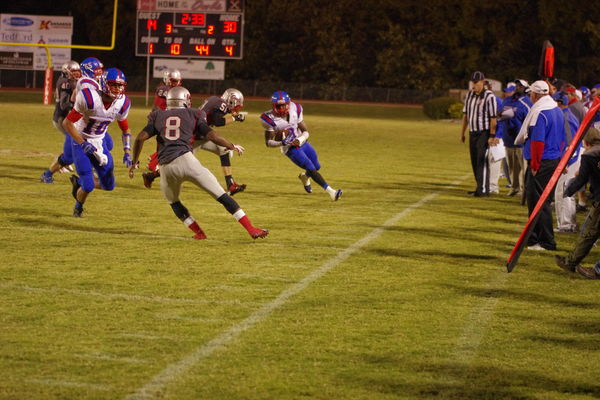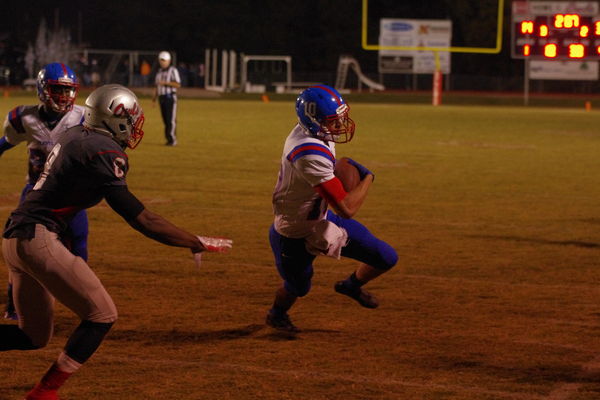Two Tone Photo???
Oct 29, 2014 10:33:37 #
The Basics:
When photographing high school football games with my Pentax K5 and Sigma 70-200mm f:2.8, many fields have very poor lighting. Because of this, I need to raise my ISO value to 3200 or higher in order to obtain a TV of 1/640 or higher. Id prefer over 1/1000 but the lack of light doesnt permit it. On occasions I have my K20D but it has far too much noise above ISO 1600 so I mainly use it for People shots where I dont have a need for speed and the problem talked about below doesnt occur.
For my white balance, I set it to either Auto WB, or Fluorescent/Neutral, (the color of most field lights at night. Auto WB seems to look close to the best but it tends to darken everything by a stop or so. Being that light is low to start with, I favor Fluorescent/Neutral which brightens everything much of the time and definitely looks the best.
Concerning my K5; at the above settings, I often get an upper half, lower half, or complete coverage of a tungsten-like look on my photos. In other words, when fire off several shots, I might have one that looks very good, one that has the lower half looking brownish/orange with the upper half looking good, another that has the upper half looking brownish/orange with the lower half looking good, and still another that looks entirely brownish/orange. This happens only at ISO 3200 or higher and for the entire game at night.
My question is, why?
Does anyone have any thoughts on this problem? At first I thought it was the angle of the lights on the field but now I dont really know.
When photographing high school football games with my Pentax K5 and Sigma 70-200mm f:2.8, many fields have very poor lighting. Because of this, I need to raise my ISO value to 3200 or higher in order to obtain a TV of 1/640 or higher. Id prefer over 1/1000 but the lack of light doesnt permit it. On occasions I have my K20D but it has far too much noise above ISO 1600 so I mainly use it for People shots where I dont have a need for speed and the problem talked about below doesnt occur.
For my white balance, I set it to either Auto WB, or Fluorescent/Neutral, (the color of most field lights at night. Auto WB seems to look close to the best but it tends to darken everything by a stop or so. Being that light is low to start with, I favor Fluorescent/Neutral which brightens everything much of the time and definitely looks the best.
Concerning my K5; at the above settings, I often get an upper half, lower half, or complete coverage of a tungsten-like look on my photos. In other words, when fire off several shots, I might have one that looks very good, one that has the lower half looking brownish/orange with the upper half looking good, another that has the upper half looking brownish/orange with the lower half looking good, and still another that looks entirely brownish/orange. This happens only at ISO 3200 or higher and for the entire game at night.
My question is, why?
Does anyone have any thoughts on this problem? At first I thought it was the angle of the lights on the field but now I dont really know.
Oct 29, 2014 10:37:01 #
GENorkus wrote:
The Basics: br When photographing high school foot... (show quote)
I'll take a shot in the dark {no pun intended} "lens hood?"
Oct 29, 2014 11:12:40 #
GENorkus wrote:
The Basics: br When photographing high school foot... (show quote)
It would help to see an example....
Oct 29, 2014 11:46:34 #
Is it possible that you have your finger partially in front of the lens when shooting? This will definitely produce a brownish tone on part of the captured image. Prior to the post processing era, there were some photographers who were quite skilled at doing this intentionally for special effect.
Oct 29, 2014 12:42:23 #
It's not the stock lens hood nor is it my finger. (Been in the photo business too long for that kind of errors!! LoL)
**From what I've been able to figure out, it only happens at higher ISO ratings and only when I use the Floresent/Neutral white balance, and only at high school fields that don't have very good lighting. In addition, my EV is set to zero. *(Yea, I know. Don't use those settings.)LoL
No one was in front of me. Do you think it could be the lighting reflecting off the grass, or not reflecting off the grass?
**From what I've been able to figure out, it only happens at higher ISO ratings and only when I use the Floresent/Neutral white balance, and only at high school fields that don't have very good lighting. In addition, my EV is set to zero. *(Yea, I know. Don't use those settings.)LoL
No one was in front of me. Do you think it could be the lighting reflecting off the grass, or not reflecting off the grass?
Oct 29, 2014 13:16:02 #
I would kill to be in the 1600 ISO range. I am Normally in the 6400 range and still struggling to keep my shutter speed up.
Oct 29, 2014 13:20:32 #
GENorkus wrote:
......... Do you think it could be the lighting reflecting off the grass, or not reflecting off the grass?
is the playing field crowned for water drainage?
Oct 29, 2014 13:44:40 #
oldtigger wrote:
is the playing field crowned for water drainage?
I'd say they are all a bit crowned so my answer to that would be no more than normal. Your answer makes me think about "wet" grass and reflection.
The later in the game, the more it shows up. Could it be my shutter giving me an advanced warning that it is going bad?
As I eluded to prior, some are show dark on top, some on bottom, some totally, and some don't at all or very little at best.
Note: Photo's #1 and #2 were taken only a few seconds apart in the closing couple minutes of the game, as seen on the timer scoreboard in back.
#2

Oct 29, 2014 14:51:14 #
There was a discussion last week about a similar thing. I searched but didn't find it. I was suggested the two tone photo was caused by the lights flickering. Seems all lights flicker. Maybe????????
Oct 29, 2014 15:05:24 #
Football fields have notoriously uneven lighting. The human eye compensates for this by automatic aperture changes. When the camera exposure is set manually the camera cannot adjust for changes in light levels automatically. If you are adjusting to centre the meter manually you should be aware that your light meter is set to SPOT. The dark section of grass close to you is probably a combination of light intensity and reflection off the grass. The more vertical the light striking the grass the less reflection you get and thus a lower luminance. There is distinct magenta cast on your first image which is easy to correct in post.
Oct 29, 2014 16:54:08 #
mcveed wrote:
When the camera exposure is set manually the camera cannot adjust for changes in light levels automatically...
The dark section of grass close to you is probably a combination of light intensity and reflection off the grass. The more vertical the light striking the grass the less reflection you get and thus a lower luminance...
When the camera exposure is set manually the camera cannot adjust for changes in light levels automatically...
The dark section of grass close to you is probably a combination of light intensity and reflection off the grass. The more vertical the light striking the grass the less reflection you get and thus a lower luminance...
If I'm not mistaken, your implying that a manually set camera WB will "catch" and average out, the 60 cycle flicker at lower shutter speeds to a degree. That tells me, a faster shutter will "catch" more of the "darker" periods.
Just last week I covered a pro football game from the field and counted the lights so I could compare things. (Go Texans!)
Pros use about five times more lighting. (Probably so national TV won't have problems.) LoL
Assuming each bank has the same cycle rate and the pros have twice as many banks as the HS fields, the banks would then average out darker periods of the other banks.
(Interesting thought.)
Oct 29, 2014 18:59:14 #
GENorkus wrote:
It's not the stock lens hood nor is it my finger. ... (show quote)
I wish I could help-- but at this point I don't have an educated guess. Good Luck.
Oct 29, 2014 19:29:09 #
Frank2013
Loc: San Antonio, TX. & Milwaukee, WI.
GENorkus wrote:
I'd say they are all a bit crowned so my answer to... (show quote)
I would lean toward shutter thoughts. I have no fact to base this on other than what you have said (some are show dark on top, some on bottom, some totally) and just looking at your photos. Does it ever happen elsewhere? (The later in the game, the more it shows up.) Is that the only time you have a fairly intensive shoot?
Oct 29, 2014 21:07:58 #
Frank2013 wrote:
Does it ever happen elsewhere?
(The later in the game, the more it shows up.) Is that the only time you have a fairly intensive shoot?
(The later in the game, the more it shows up.) Is that the only time you have a fairly intensive shoot?
To answer:
Q1
No. I've never had a need for fast photography in low lighting, before this year.
Q2
No. I cover sports often and use faster shutter speeds often, but the light is normally enough not to need a high ISO.
My present thoughts:
Brought up before was a wet/damp grass field and that makes me wonder. Only one time have I ever photographed in the rain and that was very lite and short. (I used all the rain gear so I wasn't to concerned.)
I'm now wondering if the lite fog is causing my problem. Being it only shows up a few hours after sunset, that's when the dew starts forming around here. (I'm near the Smoky Mountains in South East Tennessee.) Just like auto headlights, light bounces off wet stuff or damp stuff in my case.
Oct 29, 2014 22:54:29 #
Frank2013
Loc: San Antonio, TX. & Milwaukee, WI.
GENorkus wrote:
To answer: br br Q1 br No. I've never had a need ... (show quote)
You say (Concerning my K5; at the above settings, I often get an upper half, lower half, or complete coverage of a tungsten-like look on my photos. ) and (This happens only at ISO 3200 or higher and for the entire game at night.) I don't think dew or fog is causing this effect. Take some night photos where you need iso 3200 or higher in similar light conditions (tennis court or somewhere) and see if you get same results. I think there is some kind of camera problem from the looks of the picture you posted.
If you want to reply, then register here. Registration is free and your account is created instantly, so you can post right away.







